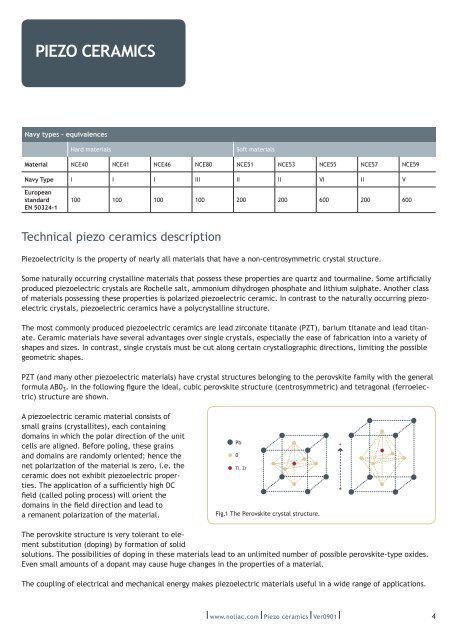Piezo ceramics.pdf
Piezo ceramics.pdf
Piezo ceramics.pdf
Create successful ePaper yourself
Turn your PDF publications into a flip-book with our unique Google optimized e-Paper software.
<strong>Piezo</strong> <strong>ceramics</strong><br />
Navy types - equivalences<br />
Hard materials<br />
Soft materials<br />
Material NCE40 NCE41 NCE46 NCE80 NCE51 NCE53 NCE55 NCE57 NCE59<br />
Navy Type I I I III II II VI II V<br />
European<br />
standard<br />
EN 50324-1<br />
100 100 100 100 200 200 600 200 600<br />
Technical piezo <strong>ceramics</strong> description<br />
<strong>Piezo</strong>electricity is the property of nearly all materials that have a non-centrosymmetric crystal structure.<br />
Some naturally occurring crystalline materials that possess these properties are quartz and tourmaline. Some artificially<br />
produced piezoelectric crystals are Rochelle salt, ammonium dihydrogen phosphate and lithium sulphate. Another class<br />
of materials possessing these properties is polarized piezoelectric ceramic. In contrast to the naturally occurring piezoelectric<br />
crystals, piezoelectric <strong>ceramics</strong> have a polycrystalline structure.<br />
The most commonly produced piezoelectric <strong>ceramics</strong> are lead zirconate titanate (PZT), barium titanate and lead titanate.<br />
Ceramic materials have several advantages over single crystals, especially the ease of fabrication into a variety of<br />
shapes and sizes. In contrast, single crystals must be cut along certain crystallographic directions, limiting the possible<br />
geometric shapes.<br />
PZT (and many other piezoelectric materials) have crystal structures belonging to the perovskite family with the general<br />
formula AB0 3 . In the following figure the ideal, cubic perovskite structure (centrosymme tric) and tetragonal (ferroelectric)<br />
structure are shown.<br />
A piezoelectric ceramic material consists of<br />
small grains (crystallites), each containing<br />
domains in which the polar direction of the unit<br />
cells are aligned. Before poling, these grains<br />
and domains are randomly oriented; hence the<br />
net polari zation of the material is zero, i.e. the<br />
ceramic does not exhibit piezoelectric properties.<br />
The application of a sufficiently high DC<br />
field (called poling process) will orient the<br />
domains in the field direction and lead to<br />
a remanent polarization of the material.<br />
Pb<br />
0<br />
Ti, Zr<br />
Fig.1 The Perovskite crystal structure.<br />
+<br />
The perovskite structure is very tolerant to element<br />
substitution (doping) by formation of solid<br />
solutions. The possibilities of doping in these materials lead to an unlimited number of possible perovskite-type oxides.<br />
Even small amounts of a dopant may cause huge changes in the properties of a material.<br />
The coupling of electrical and mechanical energy makes piezoelectric materials useful in a wide range of applications.<br />
www.noliac.com <strong>Piezo</strong> <strong>ceramics</strong> Ver0901 4
















